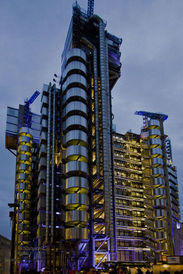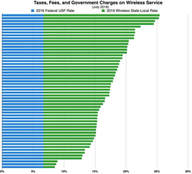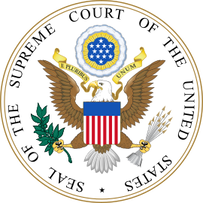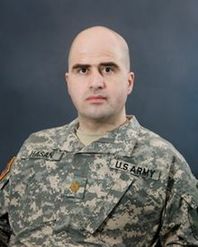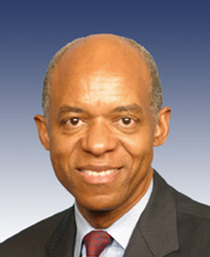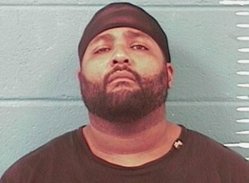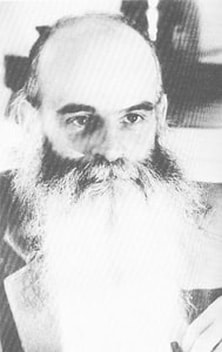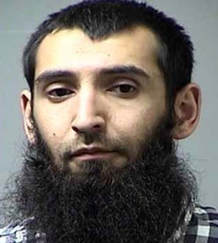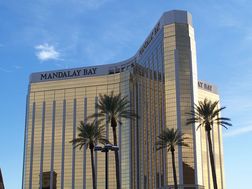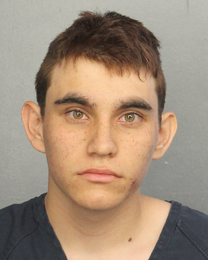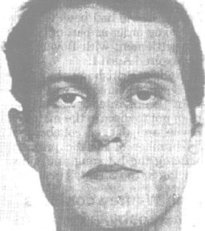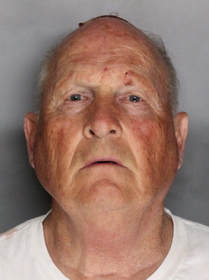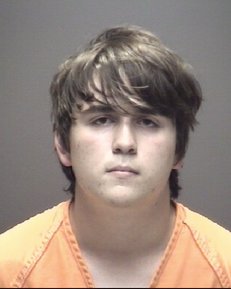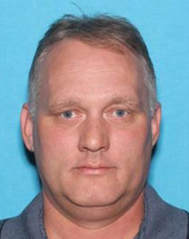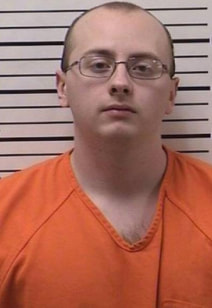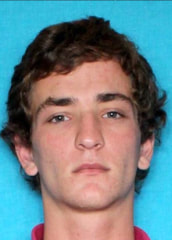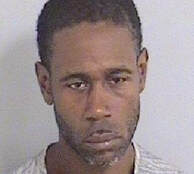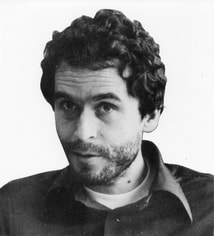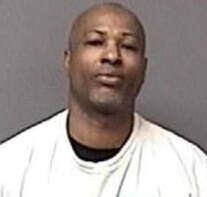In Memory of
Mr. Raymond Johnson
Mr. Raymond Johnson
|
|
This post and/or page contains affiliate links, at no additional cost
to you I am compensated only if you purchase after clicking on the links.
to you I am compensated only if you purchase after clicking on the links.
Frank Guinn and J. J. Beal v. United States |
This post and/or page contains affiliate links, at no additional cost
to you I am compensated only if you purchase after clicking on the links.
to you I am compensated only if you purchase after clicking on the links.
Meanwhile, across what pond?
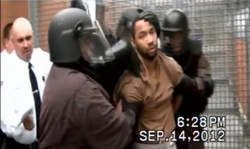
"Ronell E. Wilson (born May 4, 1982) was convicted of the 2003 capital murder of two undercover New York City police officers in Staten Island, New York. His trial before Judge Nicholas Garaufis of the United States District Court for the Eastern District of New York began on November 27, 2006. On December 20, 2006, he was found guilty of the capital murders as well as other related charges. On January 30, 2007, Wilson was sentenced to death, the first such sentence by a federal jury in New York since the federal death penalty was reinstated in 1988. Prosecutors alleged Wilson was the leader of a violent drug gang called the Stapleton Crew that originated in the Stapleton housing projects of Staten Island. He was convicted for murdering NYPD Detectives James Nemorin and Rodney Andrews in a gun sale, then searching their bodies and stealing their car. The victims' family members and fellow police officers greeted pronouncement of his death sentence with cheers and applause; Wilson reacted by sticking his tongue out in their direction. After Wilson's death sentence was vacated by the Second Circuit Court of Appeals, he was moved from the United States Penitentiary in Terre Haute, Indiana to the Metropolitan Detention Center in Brooklyn, New York. While in the MDC, he fathered a child with prison guard Nancy Gonzalez during an illicit rendezvous in the "activity room" on July 15, 2012. On March 22, 2013 Gonzalez gave birth to a son they named Justus. The Wilson's attorneys are pressing an argument stating that he is mentally disabled and therefore not eligible for the death penalty based on the 2002 U. S. Supreme Court ruling outlawing the execution of mentally disabled offenders. The prosecutor in the original case, Jack Smith, is now the Chief of the Public Integrity Section of the Department of Justice. On July 24, 2013, a Brooklyn federal jury sentenced Wilson to death for the 2003 murders, reinstating the previous death sentence that was thrown out in 2010."
Source: Wikipedia.org November 4, 2013 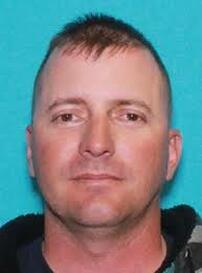 "Ivan Lopez" "Ivan Lopez"
"On April 2, 2014, [a] mass shooting occurred at the Fort Hood military base near Killeen, Texas. Four people, including the gunman, were killed, while sixteen additional people were injured. The shooter, 34-year-old Ivan Lopez, died of a self-inflicted gunshot wound. Immediately prior to the shooting, Lopez tried to seek a leave form, but was informed that he would have to come back later to try and retrieve it. At approximately 4:00 p.m., he opened fire with a .45-caliber Smith & Wesson M&P pistol inside a medical brigade building, hitting several soldiers. He then went to another building, where he continued firing. Roughly fifteen minutes after the shooting first started, Lopez was confronted by an unidentified female military police officer, prompting him to commit suicide. It was later revealed that Lopez, who was in uniform at the time of the shooting, wasn't authorized to carry a concealed firearm. The Bell County Sheriff's Office dispatched deputies and troopers from the Texas Department of Public Safety to the nearby post after receiving reports of an "active shooter," sheriff's Lt. Donnie Adams said. FBI spokeswoman Michelle Lee said its agents were also headed to the scene. The base confirmed the shooting in a brief statement posted online on April 2, 2014. On its Twitter feed and Facebook page, Fort Hood officials ordered everyone on base to "shelter in place" during the shooting. The injured victims were taken to Scott & White Memorial Hospital and Carl R. Darnall Army Medical Center. Reacting to the incident, President Barack Obama said that he was left "heartbroken" and assured that the events would be investigated. The base was previously the scene of a mass shooting in 2009, in which 13 people were killed and more than 30 wounded. The shooter was identified as 34-year-old Ivan Lopez, an Iraq War veteran who was born in Guayanilla, Puerto Rico. He previously served in the Puerto Rico National Guard from 1999 to 2010 and also joined the United States Army in June 2008. He was married and had four children. In 2011, he served a four-month tour in Iraq. Lopez was a specialist assigned to the 13th Sustainment Command, a logistics and support unit at Fort Hood. He was previously assigned in Fort Bliss, but moved to Fort Hood two months prior to the shooting. Lopez was allegedly distraught over the deaths of his mother and grandfather during a two-month period five months prior to the shooting, and was also undergoing psychiatric treatment for depression and anxiety. He tried to take a 24-hour leave of absence in order to attend his mother's funeral, but it took five days for the leave to be approved, which allegedly upset him. During a press conference on the day of the shooting, Fort Hood Commander Mark A. Milley stated that Lopez died of a self-inflicted gunshot wound. On March 1, one month prior to the shooting, Lopez allegedly purchased the weapon used in the shooting from Guns Galore, the same store where Nidal Malik Hasan, the convicted perpetrator of the 2009 Fort Hood shooting, purchased his own weapon. During that same month, he had seen a psychologist and was prescribed Ambien for a sleeping problem."
Source: Wikipedia.org April 25, 2014 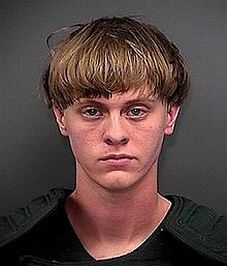 "Dylann Storm Roof" "Dylann Storm Roof"
"Dylann Storm Roof (born April 3, 1994) is an American suspected of perpetrating the June 17, 2015 Charleston church shooting. During a prayer service at Emanuel African Methodist Episcopal Church, Roof claimed to have killed nine African Americans, including senior pastor and state senator Clementa C. Pinckney, and injured one other person. After several people identified Roof as the main suspect, he became the center of a manhunt that ended the morning after the shooting with his arrest in Shelby, North Carolina. He later confessed that he committed the shooting in hopes of igniting a race war. Three days after the shooting, a website titled The Last Rhodesian was discovered and later confirmed by officials to be owned by Roof. The website contained photos of Roof posing with symbols of white supremacy and neo-Nazism, along with a manifesto in which he outlined his views towards blacks, among other peoples. He also claimed in the manifesto to have developed his white supremacist views following research on the 2012 shooting of Trayvon Martin and "black-on-white crime." Roof has been charged with nine counts of murder, three counts of attempted murder, and possession of a firearm during the commission of a felony. He also faces federal hate crime charges, for which he faces the death penalty. His trial in state court will start on July 11, 2016. Dylann Roof was born in Columbia, South Carolina, to Franklin Bennett. Roof, a carpenter, and Amelia "Amy" Cowles, a bartender. Both were divorced but temporarily reconciled at the time of his birth. When Roof was five, his father married Paige Mann Hastings in November 1999, but they divorced after ten years of marriage. Bennett Roof was allegedly verbally and physically abusive towards Mann. The family mostly lived in South Carolina [although] from about 2005 to 2008, they temporarily moved to the Florida Keys. There is no information about Roof attending local schools there. According to a 2009 affidavit filed for Mann's divorce, Roof exhibited signs of obsessive–compulsive disorder as he grew up, obsessing over germs and insisting on having his hair cut in a certain style. When he was in middle school, he exhibited an interest in smoking marijuana, having once been caught spending money on it. On the evening of June 17, 2015, a mass shooting took place at Emanuel African Methodist Episcopal Church in downtown Charleston, South Carolina, United States. During a routine Bible study at the church, a white man about 21 years old, later identified as Roof, opened fire with a handgun, killing nine people. Roof was unemployed and living in largely African-American Eastover at the time of the attack. On July 16, Roof's trial in state court was scheduled by Circuit Court Judge J. C. Nicholson to start on July 11, 2016. On July 20, Roof was ordered to provide handwriting samples to investigators. The order explained that following his arrest in Shelby, notes and lists were found written on his hand and at other locations; that the handwriting samples were needed to determine if the handwriting matched. Roof reappeared in state court on October 23, 2015, at 2:00 p.m. and is scheduled to reappear on February 5, 2016, at 9:00 a.m., before Nicholson."
Source: Wikipedia.org | December 17, 2015, 2:00PM | YouTube 12/15/2016 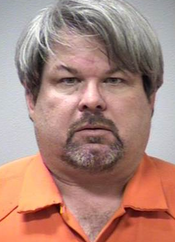 "Jason Brian Dalton" "Jason Brian Dalton"
"On the night of February 20–21, 2016, six people were killed and two others injured in a series of random shootings that took place at an apartment complex, outside a Cracker Barrel restaurant, and a car dealership in Kalamazoo County, Michigan. Police have detained a "strong suspect," later identified as Jason Dalton. The shootings began around 5:45 p. m. when a woman was shot multiple times in a Kalamazoo apartment parking lot; the woman survived but is in critical condition. About three hours later, the shooter arrived at a Kia dealership in Kalamazoo, where he shot and killed two people. This was followed by a third shooting outside a Cracker Barrel restaurant in Texas Township, where four people seated inside two vehicles were killed and one other person was wounded. Police believe none of the victims at the separate scenes were connected. Police have identified the suspect in the shootings as Kalamazoo resident Jason Brian Dalton, who is 45. Police detained the suspect around 12:40 a. m. after pulling over his vehicle, a black Chevrolet HHR, which matched the description of the getaway vehicle in the shootings. Police found a semi-automatic handgun in the car. Police indicated that Dalton had no known criminal history. According to documents released by the Kalamazoo Department of Public Safety, Dalton was born on June 22, 1970. Dalton is believed to have attended Comstock High School in Kalamazoo, graduating in 1989. Dalton worked as a driver for Uber and purportedly took fares between shooting incidents. An Uber representative stated that Dalton had passed company background checks. Dalton was married and had two children at the time of the shootings. The fatalities include a father and his 18-year-old son; and four women aged 60, 63, 68, and 74. A 14-year-old girl who was with the four women was initially included in the fatalities, but later confirmed to have survived. Joe Sullivan, Uber's Chief Security Officer, released a statement reading, "We are horrified and heartbroken at the senseless violence in Kalamazoo, Michigan. Our hearts and prayers are with the families of the victims of this devastating crime and those recovering from injuries. We have reached out to the police to help with their investigation in any way that we can."
Source: Wikipedia.org | ABC World News, February 21, 2016, 5:15PM 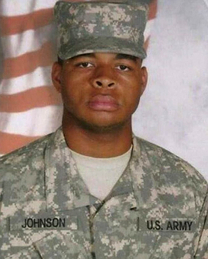 "Micah Xavier Johnson" "Micah Xavier Johnson"
"On July 7, 2016, at the end of a peaceful protest, Micah Xavier Johnson ambushed and shot twelve police officers and two civilians in Dallas, Texas, United States, killing five of the officers. Johnson was an African American Army Reserve veteran who expressed his hatred of white people and was reportedly angry over recent police shootings of black men. The protest was being held against police killings in the aftermath of the shooting deaths of Alton Sterling in Baton Rouge, Louisiana, and Philando Castile in Falcon Heights, Minnesota, in the preceding days. Following the shooting, police confronted Johnson at a parking garage, and a standoff ensued. Police eventually killed Johnson with a bomb attached to a bomb-disposal robot. The shooting was the deadliest incident for U. S. law enforcement since the September 11 terrorist attacks. A protest was organized in Dallas by the Next Generation Action Network in response to the killings of two men, Alton Sterling and Philando Castile, by police officers in Louisiana and Minnesota respectively, days before. The Dallas protest was one of several held across the U. S. on the night of July 7. Around 800 protesters were involved, and around 100 police officers were assigned to protect the event and the surrounding area. Before the shooting occurred, no other incidents were reported and the event was peaceful. The gunfire first started in downtown Dallas at 8:58 p. m. A bystander reported hearing 50 to 75 shots. Dallas Police Chief David O. Brown said that some of the officers were shot in the back, and that the shooter had some knowledge of the protest route. Another bystander, who recorded cell phone video of the event from his hotel balcony, reported observing the shooter, who was clad in tactical clothing and armed with a rifle. The bystander stated that the shooter loaded his rifle and began firing indiscriminately to draw officers near his position. When one officer approached a corner, the shooter engaged him in a gunfight, forcing the officer to take cover behind a concrete pillar. The shooter fired at one side of the pillar, then ran over to the other side, ambushed the officer, and shot him multiple times from behind at point-blank range, killing him. After firing additional gunshots into the officer's body, the gunman fled upon being shot at by additional officers. Following the shooting, the gunman engaged officers in a standoff at a nearby parking garage, firing intermittently at them. One officer was injured in the shootout. A suspicious package was discovered near the garage and was secured by a bomb squad. Chief Brown later stated that the gunman had declared that the end was near, his intentions were to kill more law enforcement personnel, and that he had placed explosives all over the garage and downtown Dallas. During negotiations, Johnson said that he acted alone and was not part of any group. The standoff ended in the early hours of July 8, after the shooter was killed by a C-4 bomb deployed and set off by a robot. A sweep of downtown Dallas found no presence of explosives. Micah Xavier Johnson was a resident of Mesquite, Texas. He graduated from John Horn High School in 2009. Johnson had served in the U. S. Army Reserve from March 2009 to April 2015, serving as a carpentry and masonry specialist. Johnson held the rank of private first class and was deployed to Afghanistan from November 2013 to July 2014 with the 420th Engineer Brigade. Johnson received the Army Achievement Medal and a NATO Medal for his tour of duty in Afghanistan. He left the Army Reserve following his return from Afghanistan and was working as an aide for mentally challenged children prior to his death. He had no criminal record in Texas. Five officers were killed and nine people—seven officers and two civilians—were injured in the shooting. The deaths of five officers in the shooting made this the deadliest incident for police officers in the United States since the September 11 attacks, surpassing two 2009 shootings in Lakewood, Washington, and Oakland, California, where four officers each were killed."
Source: CBS Evening News w/ Scott C. Pelley, July 8, 2016, 5:30PM-6:00PM | Wikipedia.org, 8:00PM | ABC newsmagazine “20/20,” July 8, 2016, 8:00PM-9:00PM 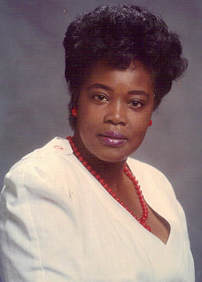 "Katherine Johnson" "Katherine Johnson"
"The near-fatal back shooting of Mr. Sammy Johnson occurred on Monday, October 30, 1995. The [back] shooting of Walter Scott occurred on April 4, 2015, in North Charleston, South Carolina, following a daytime traffic stop for a non-functioning brake light. Scott, an unarmed black man, was fatally shot by Michael Slager, a white North Charleston police officer. Slager was charged with murder after a video surfaced which showed him shooting Scott from behind while Scott was fleeing, and which contradicted his police report. The race difference led many to believe that the shooting was racially motivated, generating a widespread controversy. The case was independently investigated by the South Carolina Law Enforcement Division. The Federal Bureau of Investigation, the Office of the U. S. Attorney for the District of South Carolina, and the Justice Department's Civil Rights Division conducted their own investigations. In June 2015, a South Carolina grand jury indicted Slager on a charge of murder. He was released on bond in January 2016. In late 2016, a five-week trial ended in a mistrial due to a hung jury. In May 2016, Slager was indicted on federal charges including violation of Scott's civil rights and obstruction of justice. In a May 2017 plea agreement, Slager pleaded guilty to federal charges of civil rights violations, and he was returned to jail pending sentencing. In return for his guilty plea, the state's murder charges were dropped. In December 2017, Slager was sentenced to 20 years in prison. Walter Lamar Scott (February 9, 1965–April 4, 2015) was a forklift operator, studying massage therapy. An arrest warrant had been issued since a January 16, 2013 court hearing regarding his child support payments. Scott had previously been jailed three times because of the child support payments. Scott previously served two years in the U. S. Coast Guard before being given a general discharge in 1986 for a drug-related incident. Michael Thomas Slager (born November 14, 1981) 33 years old at the time of the incident, served in the North Charleston Police Department for five years and five months prior to the shooting. Before becoming a police officer, he served in the U. S. Coast Guard. Slager was named in a police complaint in 2013 for allegedly using a Taser on a man without cause. Slager was cleared by the police department over the incident; the victim and several witnesses said they were not interviewed. Following the Scott killing, North Charleston police stated they would re-review the 2013 complaint. Slager was named in a second tasing-without-cause complaint following an August 2014 police stop. A complaint filed in January 2015 resulted in Slager being cited for failing to file a report. Personnel documents describe Slager as having demonstrated "great officer safety tactics" in dealing with suspects, and note his proficiency with a Taser. At 9:30 a.m., April 4, 2015, in the parking lot of an auto parts store at 1945 Remount Road, Slager stopped Scott for a non-functioning third brake light. Scott was driving a 1991 Mercedes, and, according to his brother, was headed to the auto parts store when he was stopped. The video from Slager's dashcam shows him approaching Scott's car, speaking to Scott, and then returning to his patrol car. Scott exited his car and fled with Slager giving chase on foot. Slager pursued Scott. Slager then fired both of his Taser cartridges. He continued to pursue Scott into a lot behind a pawn shop at 5654 Rivers Avenue, and the two became involved in a physical altercation. Slager then fired his Taser, hitting Scott. Scott fled, and Slager drew his handgun, firing eight rounds at him from behind. The coroner's report stated that Scott was struck a total of five times: three times in the back, once in the upper buttocks, and once on one of his ears. During Slager's state trial, forensic pathologist Lee Marie Tormos testified that the fatal wound was caused by a bullet that entered Scott's back and struck his lungs and heart. Official autopsy reports have not been released. Immediately following the shooting, Slager radioed a dispatcher, stating, "Shots fired and the subject is down. He grabbed my Taser." When Slager fired his gun, Scott was approximately 15 to 20 feet away and fleeing. In the report of the shooting filed before the video surfaced, Slager said he had feared for his life because Scott had taken his Taser, and that he shot Scott because he "felt threatened." A passenger in Scott's car, reported to be a male co-worker and friend, was later placed in the back of a police vehicle and briefly detained. A toxicology report showed that Scott had cocaine and alcohol in his system at the time of his death. The level of cocaine was less than half the average amount for "typical impaired drivers", according to the report. Tormos testified that Scott did not test positive for alcohol. After the police department reviewed the video, Slager was arrested on April 7 and charged with murder. On June 8, a South Carolina grand jury indicted Slager on the murder charge. The murder charge was the only charge presented to the grand jury. On January 4, 2016, after being held without bail for almost nine months, Slager was released on $500,000 bond. He was confined to house arrest until the trial, which began October 31, 2016. On December 5, the judge declared a mistrial after the jury became deadlocked with 11 of the 12 jurors favoring a conviction. A retrial had been scheduled to begin in August 2017. However, the state charges were dropped as a result of Slager pleading guilty to a federal charge. On May 11, 2016, Slager was indicted on federal charges of violating Scott's civil rights and unlawfully using a weapon during the commission of a crime. In addition, he was charged with obstruction of justice as a result of his statement to state investigators that Scott was moving toward him with the Taser when he shot him. Slager pleaded not guilty, and a trial was scheduled to begin in May 2017. Slager faced up to life in prison if convicted. On May 2, 2017, as part of a plea agreement, Slager pleaded guilty to a violation of 18 U. S. C. § 242, deprivation of rights under color of law. In return for the guilty plea, the charges of obstructing justice and use of a firearm during a crime of violence were dismissed. On December 7, 2017, a federal judge sentenced Slager to 20 years in prison. Although defense attorneys had argued for voluntary manslaughter, the judge agreed with prosecutors that the "appropriate underlying offense" was second-degree murder. Because there is no parole in the federal justice system, Slager will likely remain in prison about 18 years after credit for time served in jail. In an out-of-court settlement, the City of North Charleston agreed in October 2015 to pay $6.5 million to Scott's family." On Monday, October 30, 1995, Mr. Sammy Johnson (born Wednesday, December 7, 1955) formerly of 39197 Hwy 929, Prairieville, LA was also shot in the back. Mr. Johnson was shot at the hand of his own sibling while Mr. Johnson was attempting to simply change a light bulb in the Heir home the two were sharing together. The wood framed house was left by Mr. Johnson's father, the Late Mr. Jessie James Johnson (1912-1989). Without any obvious provocation whatsoever, Ms. Johnson fired two shots in rapid succession of one another, one of which struck Mr. Johnson in his back. Mr. Johnson received aid from a nearby neighbor & was subsequently flown by helicopter to the hospital. A Ms. "Katherine Johnson" (pictured above) (born Monday, August 16, 1948) was later apprehended that same day and was allegedly & originally charged with "Attempted Second Degree Murder." Ms. Johnson was later released from the Ascension Parish jailhouse allegedly on a lesser charge. The weapon used is believed to have been a .45 Caliber handgun. Currently, she's believed to be residing in Orleans Parish. Her exact physical address is not known by the victim, Mr. Sammy Johnson. Mr. Johnson yet resides in Ascension Parish, State of Louisiana. Following surgery at the "Our Lady of the Lake Regional Medical Center" Baton Rouge, LA between October 30, 1995-November 7, 1995, one of Mr. Johnson's attending physicians stated to him, "you're a lucky man, the bullet just missed your spleen." This is the only really platform that the victim, Mr. Sammy Johnson, has had so far to tell his side to this sordid story.
Source: Wikipedia.org | December 10, 2017, 9:29AM | updated August 16, 2018, 9:29AM | Post updated by ClassicShoppes.us, February 2, 2019, 9:00 AM CDT 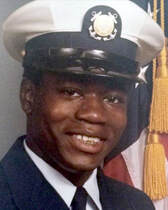 "Walter Lamar Scott" "Walter Lamar Scott"
"Walter Lamar Scott was a 50-year-old forklift operator, studying massage therapy. An arrest warrant had been issued since a January 16, 2013, court hearing regarding his child support payments, for which he had previously been jailed three times. Scott previously served two years in the U. S. Coast Guard before being given a general discharge in 1986 for a drug-related offense. Following his sudden, unlawful demise and in subsequent litigation it appears that a wrongful death lawsuit settled for $6.5 million."
Source: Wikipedia.org | Updated January 11, 2023, 11:00 PM CDT 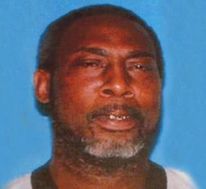 "Michael Aikens" "Michael Aikens"
"Three men arrested for Gonzales triple murder." "LA (WAFB)-Three men are behind bars for the brutal murders of three Gonzales residents last month. The Ascension Parish Sheriff's Office says Michael Aikens, 35, Rolondo Stewart, 22, and Travis Moore, 19, were arrested Tuesday afternoon for the murders of Robert and Shirley Marchand, and Shirley's son, Douglas Dooley. Aikens worked for the couple. According to reports, more arrests could be pending. Deputies say all three victims were found February 18th at the Marchand's home on Babin Road with their throats slashed and signs of blunt trauma. There were no signs of forced entry. Robert Marchand, 74, and Douglas Dooley, 50, were pronounced dead at the scene. Shirley Marchand, 72, clung to life for two weeks after the attack, but later succumbed to her injuries. A safe containing gold coins worth an estimated $500,000 was stolen from the residence. It was found two days later at a park in Livingston Parish. The bottom of the safe had been torched open and most of the coins had been stolen. All three men have been charged with three counts of first degree murder, three counts of armed robbery and three counts of aggravated burglary." The subject, known as Michael Aikens, 35, was also one of four suspects in the Aggravated Burglary, Attempted Murder and Robbery of local resident, Mr. Sammy Johnson, (born, Wednesday, December 7, 1955) formerly of 39197 Hwy 929, Prairieville, LA, some years earlier in May of 1997. In mid 2001, Aikens was identified by Mr. Johnson, the victim in the 1997 crime but he was never arrested and charged in that crime. Aikens accomplices in the May 1997 crime in Prairieville are not believed to be the same ones named in the horrifying brutal murder in Gonzales. It is said, that Michael Aikens, who may have been a "Hired Killer," is now serving a prison sentence of three consecutive life terms in a state penitentiary; but only for his part in the brutal & horrifying triple murders.
Source: WAFB TV News 9 in 2012, preserved and documented herein on Tuesday, October 18, 2016, 12:13AM | “Copyright 2012 WAFB. All rights reserved” |
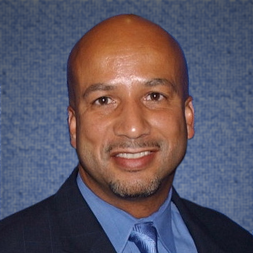 "Clarence R. Nagin, Jr." "Clarence R. Nagin, Jr."
"Clarence R. Nagin, Jr. (born June 11, 1956), also known as C. Ray Nagin, was the 60th mayor of New Orleans, Louisiana from 2002 to 2010. He was formerly a consultant, entrepreneur, author, and public speaker. He became internationally known in 2005 in the aftermath of Hurricane Katrina, which devastated the New Orleans area. He was convicted in 2014 on 20 counts of corruption during his time as mayor. Nagin was first elected in March 2002 and received significant crossover vote from just about every segment of the population. He was re-elected in 2006 even though the election was held with at least two-thirds of New Orleans citizens still displaced after Katrina struck. He was term limited by law and left office on May 3, 2010. On February 12, 2014, Nagin was convicted on 20 corruption charges, including wire fraud, bribery, and money laundering related to his alleged dealings with two troubled city vendors following Hurricane Katrina disaster. On February 20, 2013, Nagin pleaded not guilty in federal court to all charges. He was convicted on 20 of 21 of these charges on February 12, 2014. Nagin was born on June 11, 1956, in New Orleans' Charity Hospital, to a modest-income family. His childhood was typical of that of urban youth, and his father held two jobs: a janitor at New Orleans City Hall by night and a fabric cutter at a clothing factory by day. After the factory shut down his father became a fleet mechanic at a local dairy, to earn sufficient pay to support his family. His mother was employed as manager of a Kmart in-store restaurant. In 1982, Nagin married Seletha Smith, a New Orleans native. Together, they have three children: Jeremy, Jarin, and Tianna. "The jury has reached a verdict in the federal corruption case against former New Orleans Mayor Ray Nagin. The former N. O. Mayor was found guilty on 20 of 21 counts, including bribery, money laundering and fraud. The jury deliberated for a total of seven hours. Prosecutors said Nagin took money, free vacations and trips, and truck loads of granite for Stone Age. Nagin denied taking bribes or giving out city contracts in exchange for favors. Jurors decided Nagin was innocent of bribery when it came to getting granite for his family's company Stone Age LLC. Prosecutors argued Nagin took more than $500,000 of bribes and committed criminal acts starting in 2005 and stretching through the next several years as the city fought to recover from Hurricane Katrina. Nagin said the bribes were actually investments. He also denied allegations that he helped Home Depot open a store in New Orleans in exchange for steering business to Stone Age. Defense attorney Robert Jenkins said they will appeal the ruling. Nagin was considered a political outsider when he was elected mayor in 2002. He held the office until he was term limited out in 2010. The judge has ordered Nagin to home incarceration until his sentencing hearing. Nagin could be looking at a significant amount of jail time. Some charges carry a maximum penalty of 20 years. On July 15, 2014, Nagin's attorney filed an appeal with the Fifth Circuit Court of Appeals. The Bureau of Prisons disregarded a judicial recommendation for Nagin to serve his time in Oakdale, La., and instead assigned him to a federal prison camp in Texarkana, Tex. On Sept. 3, 2014, a judge deemed Nagin indigent and ordered the Federal Public Defender's Office to take over his appeal. Nagin claimed to be near penniless and said he was receiving food stamps support. He reported to the aforementioned prison camp on Sept. 8, 2014. Nagin was accompanied by members of his immediate family and did not speak to reporters as he was searched and admitted through the main gate. His earliest possible release date is May 25, 2023. He was released on April 27, 2020, due to a COVID-19 scare."
Source: Twitter.com/WAFB TV February 12, 2014; Wikipedia.org September 11, 201 and May 2, 2020, 9:47 AM CDT. 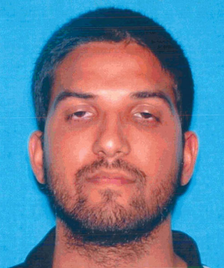 “Syed Rizwan Farook” “Syed Rizwan Farook”
"On December 2, 2015, husband and wife Syed Rizwan Farook and Tashfeen Malik shot and killed 14 people and injured 21 others at the Inland Regional Center in San Bernardino, California. They targeted a holiday party for employees of the San Bernardino County Department of Public Health, held in an auditorium with at least 100 people, before fleeing in an SUV. Farook had attended the party as an employee. After a regional manhunt, the two perpetrators were killed by police after gunfire was exchanged with them while in their vehicle, approximately four hours later. It was the second-deadliest mass shooting in California's history, after the 1984 San Ysidro McDonald's massacre, and the deadliest in the United States since the 2012 Sandy Hook Elementary School shooting. Police emphasized that no motive has yet been discovered. The FBI took over the investigation, and is treating the probe as a counter-terrorism investigation. Syed Rizwan Farook and Tashfeen Malik left their six-month-old daughter with Farook's mother the morning before the attacks, saying they were going to a doctor's appointment. Farook, a health inspector for the San Bernardino County Department of Public Health, was reportedly in attendance at the department's holiday party at the Inland Regional Center, a nonprofit facility on South Waterman Avenue serving people with developmental disabilities. There were over 100 people in attendance. Coworkers reported that he had been quiet during the early parts of the event and noticed he had left the party abruptly, leaving his coat, before a group photo was taken. There were some reports that an argument occurred before his departure. In later police briefings, it was said he left "under circumstances that were described as angry." At 10:59 am Pacific Standard Time, two perpetrators wearing ski masks and camouflage opened fire on the party-goers. Witnesses said that they recognized Farook as one of the shooters by his voice and build. A shootout on East San Bernardino Boulevard, about 1.7 miles away from the shooting, began around 3:00 pm. Police requested a BearCat and medical assistance. After the SUV was pursued and stopped, the couple exchanged fire with police from inside their vehicle, which was a black Ford Expedition SUV which Farook had rented several days previously. The gunfire lasted under a minute before both perpetrators were killed. The sheriff's department confirmed that one male and one female were killed. According to the San Bernardino police chief, during the shootout, police fired 380 rounds and the couple fired 76 rounds. Police locked down streets in the area and residents were asked to stay indoors. Police identified the dead perpetrators as Syed Rizwan Farook and Tashfeen Malik. Farook was a 28-year-old U. S. citizen, born in Illinois to Pakistani immigrants. He grew up in Riverside, California, and attended La Sierra High School, graduating in 2004, one year early. He then attended California State University, San Bernardino, receiving a bachelor's degree in environmental health in either 2009 or 2010. He was a student for one semester in 2014 at California State University, Fullerton, in their graduate program for environmental engineering, but never completed the program. Farook worked as a food inspector for the San Bernardino County Department of Public Health for five years before the shooting. From July to December 2010, he was a seasonal employee for the county. He was hired as an environmental health specialist trainee on January 28, 2012, and became a permanent employee on February 8, 2014. A coworker stated that he had not noticed Farook exhibiting any unusual behavior recently and two other coworkers described him as quiet and polite. His brother served in the U. S. Navy from 2003 to 2007, receiving multiple commendations. Malik was a 27-year-old woman originally from Pakistan who had lived in Saudi Arabia. A coworker of Farook said he went to Saudi Arabia in the spring of 2014 for about a month and married her there after meeting her through the Internet. Farook described his wife as a pharmacist; she joined him in California shortly after their wedding. They had a daughter of six months at the time of their deaths. The couple traveled to the U. S. in July 2014; Malik entered on a K-1 visa (fiancée visa) on a Pakistani passport. According to a State Department spokesman, all applicants for such visas are fully screened. Farook applied for permanent residency (a "green card") for Malik in September 2014, and she was granted a conditional green card in July 2015. Obtaining such a green card would have required the couple to prove that the marriage was legitimate, as well as required Malik to provide her fingerprints and pass criminal and national security background checks using government databases. Malik was one of a small number of female mass shooters in the United States; according to FBI statistics, women constituted only 3.75 percent of shooters of active-shooter incidents between the years 2000 and 2013."
Source: ABC & CBS Evening News, Wikipedia.org December 2-3, 2015 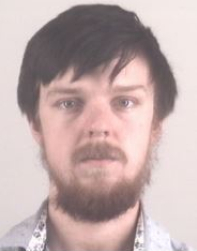 "Ethan Anthony Couch" "Ethan Anthony Couch"
"Ethan Anthony Couch (born April 11, 1997) is an American teenager given 10 years probation in juvenile court, on 4 counts of intoxication manslaughter, for recklessly driving drunk on June 15, 2013 in Burleson, Texas. He was illegally driving on a restricted license and speeding, lost control, plowed into a group of people standing near a disabled SUV and struck a parked vehicle there to assist. Four people were killed in the collision; two passengers in Couch's truck suffered serious bodily injury and a total of nine people were injured. In December 2013, Judge Jean Hudson Boyd sentenced Couch to 10 years of probation and subsequently ordered him to therapy at a long-term, in-patient facility, after his attorneys argued that the teen had "affluenza" and needed rehabilitation instead of prison. Boyd then retired as judge the following December. Couch's sentence set off what the New York Times called "an emotional, angry debate that has stretched far beyond the North Texas suburbs." Couch became the subject of a manhunt and was listed in the National Fugitive Database on December 11, 2015, after his probation officer was unable to contact him. On December 28, 2015, authorities detained Couch and his mother in the Mexican resort city of Puerto Vallarta. Couch's parents were married in Johnson County, Texas in 1996, and divorced in 2007. He grew up in Burleson and previously attended Anderson Private School. Couch drove himself to school at the age of thirteen. When the head of the school questioned that practice, his father threatened to buy the school. At the age of fifteen, Couch was cited for "minor in consumption of alcohol" and "minor in possession of alcohol," after he was caught in a parked pick-up truck with a naked, passed out 14-year-old girl. He pleaded no contest and was sentenced to probation, a compulsory alcohol awareness class, and 12 hours of community service. His parents have each had their own run-ins with the law, publicized retrospectively in the media following their son's conviction. Fred Couch has been charged with criminal mischief, theft by check and assault, but the charges were dismissed. On August 19, 2014, he was arrested for impersonating a police officer, allegedly displaying a fake badge during a disturbance call. In 2013, Tonya Couch was sentenced to a $500 fine and a six-month community supervision order for reckless driving when she used her vehicle to force another motorist off the road. On Saturday evening June 15, 2013, according to authorities and trial testimony, Couch was witnessed on surveillance video stealing two cases of beer from a Walmart store, driving with seven passengers in his father's red 2012 Ford F-350 pickup truck, and speeding 70 miles per hour in a designated 40 miles per hour zone. Three hours after the incident, he had a blood alcohol content of 0.24, three times the legal limit for adult drivers in Texas, and tested positive for Valium."
Source: Wikipedia.org January 4, 2016, 8:46AM (Photo taken February 22, 2016, 12:20AM) 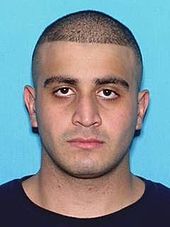 "Omar Mir Seddique Mateen" "Omar Mir Seddique Mateen"
"Omar Mir Seddique Mateen (November 16, 1986–June 12, 2016) lived about 100 miles from Orlando. Mateen was an American citizen born in New York to Afghan parents, and was a Muslim. He attended Martin County High School for at least one year and reportedly held two degrees in science from Indian River State College, received in 2006 and 2007. According to Florida Department of Law Enforcement records, he had no criminal record in Florida. Mateen lived in Fort Pierce, Florida, but received mail at his parents' home in nearby Port St. Lucie. He had worked for the security firm G4S in Jupiter, Florida, since 2007. He held an active firearms license and a security guard license. Mateen married an Uzbekistan-born wife in April 2009; they divorced in July 2011. Law enforcement sources said Mateen called 9-1-1 and pledged allegiance to ISIL leader Abu Bakr al-Baghdadi just before he started shooting. Mateen's father said, "This had nothing to do with religion," and was quoted as saying that he had seen his son get angry after witnessing a gay couple kiss at a festival marketplace in Miami months prior to the attack, which he suggested might be a motivating factor. Imam Shafiq Rahman at the Islamic Center of Fort Pierce told reporters that Mateen would come to the mosque with his father and his three-year-old son as recently as two days before the shooting, and said of him, "He was the most quiet guy. He would come and pray and leave. There was no indication at all of violence." The imam said that he did not preach violence toward homosexuals. On June 12, 2016, a mass shooting occurred at Pulse, a gay nightclub in Orlando, Florida. At least 50 people, including the gunman ["Omar Mir Seddique Mateen"] were killed and 53 others were wounded. The attack is the deadliest mass shooting in United States history."
Source: ABC World News Tonight w/ David Muir | June 12, 2016, 5:00-5:30PM | Wikipedia.org 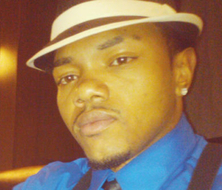 "Gavin Eugene Long" "Gavin Eugene Long"
"Gavin Eugene Long (July 17, 1987–July 17, 2016) On July 17, 2016, Gavin Eugene Long shot six police officers in Baton Rouge, Louisiana. Three died and three were hospitalized, one critically; of the officers who died, two were members of the Baton Rouge Police Department, while the third worked for the East Baton Rouge Parish Sheriff's Office. Long, who associated himself with organizations linked to black separatism and the sovereign citizen movement, was shot and killed by a SWAT officer during a shootout with police at the scene. Police arrested and questioned two other suspects, but Long was confirmed to be the only person involved in the shooting. The shooting occurred during a period of unrest in Baton Rouge, though it is unclear if the events are related. Baton Rouge was experiencing ongoing protests following the officer-involved killing of Alton Sterling less than two weeks before on July 5. On July 7, the FBI's New Orleans field office issued a warning about "threats to law enforcement and potential threats to the safety of the general public" stemming from the death of Sterling. Within the previous week, four suspects were arrested in connection with an alleged plot to kill Baton Rouge police officers, which was described as a credible threat by law enforcement officials. Ten days earlier, five police officers were killed in a mass shooting in Dallas. Long arrived at Hammond Aire Plaza, a shopping complex on Airline Highway, sometime before 8:40 a.m. CT and began scouting the area in search of police officers. He first spotted a police patrol vehicle parked at a B-Quik convenience store; it belonged to a sheriff's deputy who was working security in the area. Long parked his vehicle behind an adjacent building, got out, and prepared to shoot, but found that the vehicle was empty. He then drove north and noticed a police officer washing his vehicle a short distance away, but the officer left before Long could get close. By 8:40, police received a call about a suspicious person carrying a rifle near the plaza. When officers arrived at the scene, they found Long clad in black and wearing a face mask behind the Hair Crown Beauty Supply store on the 9600 block of Airline Highway. Shots were reportedly fired two minutes later. Another two minutes afterwards, there were reports that officers were down. According to investigators, Long fired upon the first responding officers, fatally wounding three. One of the officers was killed trying to help another. Long shot another police officer and then moved to another part of the complex, where he shot two sheriff's deputies. At 8:46, he was reported to be near Benny's Car Wash. Officers fired on Long from behind the cover of patrol cars. Eventually, a SWAT team responded to the scene; one member took aim at Long from about 100 yards away and killed him at about 8:48. Louisiana State Policesaid Long was the only person involved in the shooting. The entire shooting lasted for less than ten minutes. Long grew up in Kansas City and graduated from high school in 2005. His parents divorced when he was eleven, and his father was neglectful of Long, according to court records. He failed to appear on scheduled visits with his son while the divorce was pending, and did not deliver birthday or Christmas presents to him. Court records described one instance where Long was picked up by his father, but dropped off at a day care facility at a casino shortly after. Long served in the U. S. Marine Corps as a data network specialist from August 22, 2005, to August 1, 2010. He was honorably discharged with the rank of sergeant. During his military service, he was deployed to Iraq from June 2008 to January 2009. He was also assigned to units in San Diego, California, and Okinawa, Japan. Long was awarded the Good Conduct Medal, along with an Iraq Campaign Medal, a National Defense Service Medal, a Navy Unit Commendation, and others. Following his military service, Long told relatives and friends that he suffered from posttraumatic stress disorder, though an official diagnosis was not made clear. He reportedly had prescriptions for Ativan and Valium, both anti-anxiety drugs, as well as Lunesta, a sleep aid. Health records from the U. S. Department of Veterans Affairs reportedly indicated contacts with Long from 2008 to August 2013, with no specific details disclosed. According to Long's mother, the VA then sent him a letter denying him further treatment on the grounds that his disorder was not related to his military service. Long was identified as a "black separatist" by a U.S. law enforcement official. Social media posts indicated that he was an active member of the anti-government New Freedom Group. According to CNN, a card was found on Long's body, suggesting that he was a member of the Washitaw Nation, a group of African Americans associated with the sovereign citizen movement that originated in Richwood. Long graduated from Central Texas College in Killeen in 2011 with an associate degree, and also studied for two semesters at Clark Atlanta University, a historically black university, from 2012 to 2013. In addition, he spent a semester at the University of Alabama in the spring of 2012, with his name making it to the Dean's List as a general business major. According to local court records, Long had no criminal record and was divorced."
Source: Wikipedia.org | Monday, July 25, 2016, 12:00AM 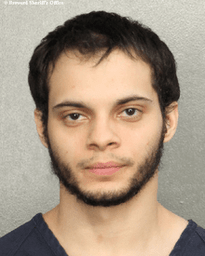 "Esteban Santiago-Ruiz" "Esteban Santiago-Ruiz"
"A mass shooting occurred at Fort Lauderdale–Hollywood International Airport in Broward County, Florida, United States, at 12:55 p.m. EST on January 6, 2017 near the baggage claim in Terminal 2. Five people were killed while six others were injured in the shooting. Up to 40 people sustained injuries in the ensuing panic. A suspect was taken into custody after surrendering to responding police officers. The assailant opened fire with a 9mm Glock semi-automatic pistol in the airport at about 12:55 p. m. EST, in the baggage claim area of Terminal 2, which is the host terminal for Delta Air Lines and Air Canada. Video showed travelers rushing out of the airport and hundreds of people waiting on the tarmac as numerous law enforcement officers rushed to the scene. Part of the panic occurred following "unfounded reports of additional gunshots," the false alarm touched off a brief panic in other terminals. Former White House Press Secretary Ari Fleischer tweeted from the airport, "Shots have been fired. Everyone is running." The shooting lasted about 70 to 80 seconds. The suspect laid down on the ground after he stopped shooting, after running out of ammunition. Broward County Sheriff Scott Israel stated that law enforcement officers did not fire shots and that the gunman was arrested without incident. The Broward County Sheriff's Office reported that five people were killed. Originally, eight people were have said to have been injured, but the sheriff clarified on January 7 that the number of people injured due to the shooting was actually six, with three admitted in intensive care units. The sheriff said that in addition to the people injured by gunshots, about 30 to 40 others were "injured in the panic" during the even. Esteban Santiago-Ruiz born March 16, 1990, a 26-year-old resident of Alaska and a military veteran, was arrested immediately after the shooting. Because the attack took place at an airport, it falls under federal criminal jurisdiction. Santiago-Ruiz was put in federal custody after the incident. Santiago flew from Ted Stevens Anchorage International Airport in Anchorageon a Delta flight, connecting through Minneapolis–Saint Paul International Airport. Investigators say that he checked a declared 9mm pistol in his baggage before retrieving it in Fort Lauderdale and loading the gun in an airport bathroom just before the attack. According to law enforcement officials, he had purchased Glock 9mm and .40 caliber pistols in the past, but it was unknown whether these were the firearms used in the attack. Santiago was reported to be carrying military identification at the time of the shooting Santiago was reportedly born in New Jersey in 1990, having moved to Puerto Rico two years later. He lived most of his life in Peñuelas, Puerto Rico, and attended high school there. He joined the Puerto Rico National Guard on December 14, 2007, and served in the Iraq War from April 23, 2010 to February 19, 2011 as a combat engineer. He later served in the Alaska Army National Guard from November 21, 2014, until receiving a general discharge in August 2016 for "unsatisfactory performance." He was a private first classand received ten awards during his time in the military. In January 2016, Santiago was arrested and charged with assault in an incident involving his girlfriend in Anchorage, Alaska. It was alleged that he was yelling at her, broke down the door, and proceeded to strangle her. The case resulted in a deferred prosecution agreement."
Source: Wikipedia.org | Sunday, January 8, 2017, 9:11PM 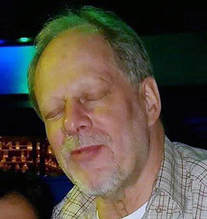 "Stephen Craig Paddock" "Stephen Craig Paddock"
"Stephen Craig Paddock (April 9, 1953–October 1, 2017) was an American mass murderer, who committed the 2017 Las Vegas Strip shooting. He fired modified semi-automatic weapons from his room on the 32nd floor of the Mandalay Bay hotel into a crowd of approximately 22,000 concertgoers at a country music festival on the Las Vegas Strip on October 1, 2017. Paddock, who lived in Mesquite, Nevada, died at the scene from a self-inflicted gunshot wound. The incident surpassed the 2016 Orlando nightclub shooting. The deadliest mass shooting by a lone gunman in U. S. history, with 58 fatalities and 489 injuries. Sean H Hockland, of Minneapolis, MN, by way of Spanaway, WA, a known associate of Paddock's is currently being held at a federal holding facility in Reno, NV for questioning in connection to the deadly shooting. Stephen Paddock was born in Clinton, Iowa. He grew up in Tucson, Arizona, and Sun Valley, California, as one of four sons of Benjamin Hoskins Paddock. Benjamin was a convicted bank robber who escaped prison in 1969, and subsequently had his name added to the FBI's most-wanted list. Stephen was 15 years old at the time. According to his brother Eric, they never really knew their father as he was never with their mother. In 1967, Paddock completed his studies at Richard E. Byrd Middle School, then graduated from John H. Francis Polytechnic High School in 1971, and from California State University, Northridge in 1977, with a degree in business administration. He worked for the federal government from about 1975 to 1985. Paddock was a letter carrier for the U. S. Postal Service from 1976 to 1978. He worked for six years as an Internal Revenue Service agent, until 1984. He was a federal auditor for one year, in 1985, focusing on defense contractors. Towards the end of the 1980s, he worked for three years as an internal auditor for a company that later merged to form Lockheed Martin. Paddock's work career after this period is not clear. However, it is known he lived in the Los Angeles area and owned personal property in areas including Panorama City,Cerritos and North Hollywood, from the 1970s to early 2000s. He owned rental properties around the country, including two run-down apartment buildings in the working-class neighborhood of Hawthorne, California. He owned an apartment complex in the Dallas suburb of Mesquite, which he sold in 2012. Relatives said Paddock was worth at least $2 million. According to court records, Paddock was married and divorced twice. He was first married from 1977 to 1979, and for the second time from 1985 to 1990, both marriages in Los Angeles County, California. According to his brother, Paddock had no political or religious affiliations of any kind. Paddock lived in Texas and in California, then in a retirement community in Melbourne, Florida from 2013 to 2015. In 2016 he moved 2,400 miles west across the country from Melbourne, Florida, to a new retiree home in Mesquite, Nevada, about 80 miles northeast of Las Vegas. According to property records, he bought a single-family home in Mesquite in 2013, and sold his two-bedroom home in Melbourne. For several years, he lived with his girlfriend in a retirement community in Reno, Nevada in addition to his home in Mesquite. An Australian acquaintance said he met Paddock in the United States and the Philippines. He described Paddock as intelligent and methodical. He alleged Paddock won a lot of money applying algorithms to gambling on machines and that he studied gun laws. The acquaintance considered Paddock a generous man whenever he and his girlfriend visited him. In 2010, Paddock applied for and received a U. S. passport. He was an avid traveler. He was on 20 cruise ship voyages, visiting several foreign ports including in Spain, Italy, Greece, Jordan and the United Arab Emirates. He was accompanied by his girlfriend on nine of them."
Source: Wikipedia.org | Saturday, October 7, 2017, 7:23PM CDT |
ClassicShoppes.us
~Where Class & Distinction Meets~
~Where Class & Distinction Meets~







